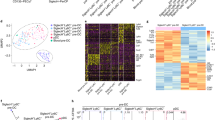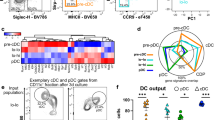Abstract
Parabiosis experiments demonstrating that dendritic cells (DCs) do not equilibrate between mice even after prolonged joining by parabiosis have suggested that DCs are derived from self-renewing progenitors that divide in situ. However, here we found that unequal exchange of DCs between mice joined by parabiosis reflected uneven distribution of DC precursors in blood due to their short half-life in circulation. DCs underwent only a limited number of divisions in the spleen or lymph nodes over a 10- to 14-day period and were replenished from blood-borne precursors at a rate of nearly 4,300 cells per hour. Daughter DCs presented antigens captured by their progenitors, suggesting that DC division in peripheral lymphoid organs can prolong the duration of antigen presentation in vivo.
This is a preview of subscription content, access via your institution
Access options
Subscribe to this journal
Receive 12 print issues and online access
$209.00 per year
only $17.42 per issue
Buy this article
- Purchase on Springer Link
- Instant access to full article PDF
Prices may be subject to local taxes which are calculated during checkout





Similar content being viewed by others
References
Liu, Y.J. Dendritic cell subsets and lineages, and their functions in innate and adaptive immunity. Cell 106, 259–262 (2001).
Shortman, K. & Liu, Y.J. Mouse and human dendritic cell subtypes. Nat. Rev. Immunol. 2, 151–161 (2002).
Steinman, R.M. et al. Dendritic cell function in vivo during the steady state: a role in peripheral tolerance. Ann. NY Acad. Sci. 987, 15–25 (2003).
Crowley, M., Inaba, K., Witmer-Pack, M. & Steinman, R.M. The cell surface of mouse dendritic cells: FACS analyses of dendritic cells from different tissues including thymus. Cell. Immunol. 118, 108–125 (1989).
Witmer, M.D. & Steinman, R.M. The anatomy of peripheral lymphoid organs with emphasis on accessory cells: light-microscopic immunocytochemical studies of mouse spleen, lymph node, and Peyer's patch. Am. J. Anat. 170, 465–481 (1984).
Vremec, D. et al. The surface phenotype of dendritic cells purified from mouse thymus and spleen: investigation of the CD8 expression by a subpopulation of dendritic cells. J. Exp. Med. 176, 47–58 (1992).
Dudziak, D. et al. Differential antigen processing by dendritic cell subsets in vivo. Science 315, 107–111 (2007).
Manz, M.G. et al. Dendritic cell development from common myeloid progenitors. Ann. NY Acad. Sci. 938, 167–173 (2001).
Traver, D. et al. Development of CD8α-positive dendritic cells from a common myeloid progenitor. Science 290, 2152–2154 (2000).
Fogg, D.K. et al. A clonogenic bone marrow progenitor specific for macrophages and dendritic cells. Science 311, 83–87 (2006).
Harman, B.C., Miller, J.P., Nikbakht, N., Gerstein, R. & Allman, D. Mouse plasmacytoid dendritic cells derive exclusively from estrogen-resistant myeloid progenitors. Blood 108, 878–885 (2006).
Colonna, M., Trinchieri, G. & Liu, Y.J. Plasmacytoid dendritic cells in immunity. Nat. Immunol. 5, 1219–1226 (2004).
Sallusto, F. & Lanzavecchia, A. Efficient presentation of soluble antigen by cultured human dendritic cells is maintained by granulocyte/macrophage colony-stimulating factor plus interleukin 4 and downregulated by tumor necrosis factor alpha. J. Exp. Med. 179, 1109–1118 (1994).
Bender, A., Sapp, M., Schuler, G., Steinman, R.M. & Bhardwaj, N. Improved methods for the generation of dendritic cells from nonproliferating progenitors in human blood. J. Immunol. Methods 196, 121–135 (1996).
Randolph, G.J., Beaulieu, S., Lebecque, S., Steinman, R.M. & Muller, W.A. Differentiation of monocytes into dendritic cells in a model of transendothelial trafficking. Science 282, 480–483 (1998).
Randolph, G.J., Inaba, K., Robbiani, D.F., Steinman, R.M. & Muller, W.A. Differentiation of phagocytic monocytes into lymph node dendritic cells in vivo. Immunity 11, 753–761 (1999).
Geissmann, F., Jung, S. & Littman, D.R. Blood monocytes consist of two principal subsets with distinct migratory properties. Immunity 19, 71–82 (2003).
Ginhoux, F. et al. Langerhans cells arise from monocytes in vivo. Nat. Immunol. 7, 265–273 (2006).
Naik, S.H. et al. Intrasplenic steady-state dendritic cell precursors that are distinct from monocytes. Nat. Immunol. 7, 663–671 (2006).
Merad, M. et al. Langerhans cells renew in the skin throughout life under steady-state conditions. Nat. Immunol. 3, 1135–1141 (2002).
Varol, C. et al. Monocytes give rise to mucosal, but not splenic, conventional dendritic cells. J. Exp. Med. 204, 171–180 (2006).
Kamath, A.T. et al. The development, maturation, and turnover rate of mouse spleen dendritic cell populations. J. Immunol. 165, 6762–6770 (2000).
Kamath, A.T., Henri, S., Battye, F., Tough, D.F. & Shortman, K. Developmental kinetics and lifespan of dendritic cells in mouse lymphoid organs. Blood 100, 1734–1741 (2002).
Ruedl, C., Koebel, P., Bachmann, M., Hess, M. & Karjalainen, K. Anatomical origin of dendritic cells determines their life span in peripheral lymph nodes. J. Immunol. 165, 4910–4916 (2000).
Zhang, M. et al. Splenic stroma drives mature dendritic cells to differentiate into regulatory dendritic cells. Nat. Immunol. 5, 1124–1133 (2004).
Kabashima, K. et al. Intrinsic lymphotoxin-β receptor requirement for homeostasis of lymphoid tissue dendritic cells. Immunity 22, 439–450 (2005).
Bogunovic, M. et al. Identification of a radio-resistant and cycling dermal dendritic cell population in mice and men. J. Exp. Med. 203, 2627–2638 (2006).
Wright, D.E., Wagers, A.J., Gulati, A.P., Johnson, F.L. & Weissman, I.L. Physiological migration of hematopoietic stem and progenitor cells. Science 294, 1933–1936 (2001).
Abkowitz, J.L., Robinson, A.E., Kale, S., Long, M.W. & Chen, J. Mobilization of hematopoietic stem cells during homeostasis and after cytokine exposure. Blood 102, 1249–1253 (2003).
Harris, R.B., Zhou, J., Weigle, D.S. & Kuijper, J.L. Recombinant leptin exchanges between parabiosed mice but does not reach equilibrium. Am. J. Physiol. 272, R1800–R1808 (1997).
Nishizawa, Y. & Bray, G.A. Evidence for a circulating ergostatic factor: studies on parabiotic rats. Am. J. Physiol. 239, R344–R351 (1980).
Lagasse, E. & Weissman, I.L. Bcl-2 inhibits apoptosis of neutrophils but not their engulfment by macrophages. J. Exp. Med. 179, 1047–1052 (1994).
van Furth, R. & Cohn, Z.A. The origin and kinetics of mononuclear phagocytes. J. Exp. Med. 128, 415–435 (1968).
Morrison, S.J. & Weissman, I.L. The long-term repopulating subset of hematopoietic stem cells is deterministic and isolatable by phenotype. Immunity 1, 661–673 (1994).
Steinman, R.M., Lustig, D.S. & Cohn, Z.A. Identification of a novel cell type in peripheral lymphoid organs of mice. 3. Functional properties in vivo. J. Exp. Med. 139, 1431–1445 (1974).
Steinman, R.M. & Nussenzweig, M.C. Dendritic cells: features and functions. Immunol. Rev. 53, 127–147 (1980).
Pugh, C.W., MacPherson, G.G. & Steer, H.W. Characterization of nonlymphoid cells derived from rat peripheral lymph. J. Exp. Med. 157, 1758–1779 (1983).
Hawiger, D. et al. Dendritic cells induce peripheral T cell unresponsiveness under steady state conditions in vivo. J. Exp. Med. 194, 769–779 (2001).
Bonifaz, L.C. et al. In vivo targeting of antigens to maturing dendritic cells via the DEC-205 receptor improves T cell vaccination. J. Exp. Med. 199, 815–824 (2004).
Rudensky, A., Rath, S., Preston-Hurlburt, P., Murphy, D.B. & Janeway, C.A., Jr. On the complexity of self. Nature 353, 660–662 (1991).
Diao, J. et al. In situ replication of immediate dendritic cell (DC) precursors contributes to conventional DC homeostasis in lymphoid tissue. J. Immunol. 176, 7196–7206 (2006).
Redmond, W.L., Hernandez, J. & Sherman, L.A. Deletion of naive CD8 T cells requires persistent antigen and is not programmed by an initial signal from the tolerogenic APC. J. Immunol. 171, 6349–6354 (2003).
Zammit, D.J., Cauley, L.S., Pham, Q.M. & Lefrancois, L. Dendritic cells maximize the memory CD8 T cell response to infection. Immunity 22, 561–570 (2005).
Bullock, T.N., Mullins, D.W. & Engelhard, V.H. Antigen density presented by dendritic cells in vivo differentially affects the number and avidity of primary, memory, and recall CD8+ T cells. J. Immunol. 170, 1822–1829 (2003).
Catron, D.M., Rusch, L.K., Hataye, J., Itano, A.A. & Jenkins, M.K. CD4+ T cells that enter the draining lymph nodes after antigen injection participate in the primary response and become central-memory cells. J. Exp. Med. 203, 1045–1054 (2006).
Kretschmer, K. et al. Inducing and expanding regulatory T cell populations by foreign antigen. Nat. Immunol. 6, 1219–1227 (2005).
Ansel, K.M., Harris, R.B. & Cyster, J.G. CXCL13 is required for B1 cell homing, natural antibody production, and body cavity immunity. Immunity 16, 67–76 (2002).
Gordon, S. & Taylor, P.R. Monocyte and macrophage heterogeneity. Nat. Rev. Immunol. 5, 953–964 (2005).
Blasius, A. et al. A cell-surface molecule selectively expressed on murine natural interferon-producing cells that blocks secretion of interferon-α. Blood 103, 4201–4206 (2004).
Acknowledgements
We thank R. Steinman, K. Tarbell and E. Besmer for reading the manuscript. Supported by the National Institutes of Health (M.N. and J.H.), the Verto Institute (J.H.) and the Howard Hughes Medical Institute (M.N.).
Author information
Authors and Affiliations
Corresponding author
Ethics declarations
Competing interests
The authors declare no competing financial interests.
Supplementary information
Supplementary Fig. 1
Not all blood leukocytes are equally exchanged in the parabiotic system despite shared circulation. (PDF 325 kb)
Supplementary Fig. 2
Dividing DCs in lymph nodes. (PDF 386 kb)
Supplementary Fig. 3
Blood T cell clearance and exchange in parabiotic mice. (PDF 610 kb)
Rights and permissions
About this article
Cite this article
Liu, K., Waskow, C., Liu, X. et al. Origin of dendritic cells in peripheral lymphoid organs of mice. Nat Immunol 8, 578–583 (2007). https://doi.org/10.1038/ni1462
Received:
Accepted:
Published:
Issue Date:
DOI: https://doi.org/10.1038/ni1462
This article is cited by
-
Parabiosis reveals the correlation between the recruitment of circulating antigen presenting cells to the retina and the induction of spontaneous autoimmune uveoretinitis
Journal of Neuroinflammation (2022)
-
The crosstalk between macrophages and bone marrow mesenchymal stem cells in bone healing
Stem Cell Research & Therapy (2022)
-
Immune phenotypes that are associated with subsequent COVID-19 severity inferred from post-recovery samples
Nature Communications (2022)
-
Lymphoid stromal cells proGrem dendritic cell homeostasis
Nature Immunology (2021)
-
Engineered niches support the development of human dendritic cells in humanized mice
Nature Communications (2020)



